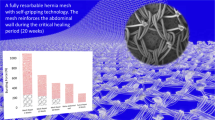Abstract
PURPOSE: Parastomal hernia formation commonly complicates permanent stomas and represents a significant and frequently recurrent management problem, regardless of the method of repair. Prosthetic material reinforcement of parastomal tissues offers the best results. However, problems with unravelling of mesh fibers along cut margins leading to aperture enlargement and hernia recurrence may occur. Raised intra-abdominal pressure in the early postoperative period before incorporation of the mesh into surrounding tissues may result in hernia formation if the aperture size in the mesh increases. METHODS: Assessment of the physical properties of Marlex® mesh was performed in a materials testing laboratory, using standardized tests to simulate the stresses imposed onin situ mesh. RESULTS: Holes cut in Marlex® mesh were found to enlarge and distort at loads simulating intra-abdominal pressure changes. Reinforcement with a polypropylene pursestring suture was found to stabilize the periaperture mesh fibers and maintain the original area throughout tensions at least double maximal intra-abdominal pressures. Distensibility of intact sheets of mesh was found to vary by up to 100 percent, depending on the direction of the applied tension, and thus, mesh orientation in hernia repair has major implications. CONCLUSION: We propose that if mesh is used to reinforce abdominal wall tissues and is cut or fashioned to size, then the cut margins must be reinforced if the intended dimensions and functional integrity of the mesh are to be maintained.
Similar content being viewed by others
References
Kodner IJ. Colostomy and ileostomy. Clin Symp 1978;30:1–36.
Golligher J. Surgery of the anus, rectum, and colon. 5th ed. London: Bailliere Tindall, 1984:703–4, 894.
Martin L, Foster G. Parastomal hernia. Ann R Coll Surg Engl 1996;78:81–4.
Cheung MT. Complications of an abdominal stoma: an analysis of 322 stomas. Aust N Z J Surg 1995;65:808–11.
De Ruiter P, Bijnen AB. Successful local repair of paracolostomy hernia with a newly developed prosthetic device. Int J Colorectal Dis 1992;7:132–4.
Rubin MS, Schoetz DJ, Matthews JB. Parastomal hernia. Is stoma relocation superior to fascial repair? Arch Surg 1994;129:413–9.
Rosin JD, Bonardi RA. Paracolostomy hernia repair with Marlex mesh: a new technique. Dis Colon Rectum 1977;20:299–302.
Abdu RA. Repair of paracolostomy hernias with Marlex mesh. Dis Colon Rectum 1982;25:529–31.
Byers JM, Steinberg JB, Postier RG. Repair of parastomal hernias using polypropylene mesh. Arch Surg 1992;127:1246–7.
Carlsen E, Bergan A. Technical aspects of complications of end-ileostomies. World J Surg 1995;19:632–6.
Sjödahl R, Anderberg B, Boin T. Parastomal hernia in relation to the site of the abdominal stoma. Br J Surg. 1988;75:339–41.
Allen-Mersch TG, Thompson JB. Surgical treatment of colostomy complications. Br J Surg 1988;75:416–8.
Ulyatt DB. Elevated intra-abdominal pressure. In: Kerr D, Thirwell J, eds. Australian anaesthesia 1992: invited papers and selected continuing education lectures. Melbourne: Australian and New Zealand College of Anaesthetists, 1992:108–11.
Kron IL, Harman PK, Nolan SP. The measurement of intra-abdominal pressure as a criterion for reexploration. Ann Surg 1984;199:28–30.
Cullen DJ, Coyle JP, Teplick R,et al. Cardiovascular, pulmonary and renal effects of massively increased intra-abdominal pressure in critically ill patients. Crit Care Med 1989;17:118–21.
Carry PY, Banssillon V. Intra-abdominal pressure. Ann Fr Anesth Reanim 1994;13:381–99.
Cresswell AG. Responses of intra-abdominal pressure and abdominal muscle activity during dynamic trunk loading in man. Eur J Appl Physiol 1993;66:315–2
King MW, Soares BM. Designing fabrics for hernia repair. Can Textile J 1993;110:18–22.
Sugarbaker PH. Peritoneal approach to prosthetics mesh repair of paraostomy hernias. Ann Surg 1985;201:344–6.
Bayer I, Kyser S, Chaimoff C. A new approach to primary strengthening of colostomy with Marlex mesh to prevent parastomal hernia. Surg Gynecol Obstet 1986;163:579–80.
Author information
Authors and Affiliations
Additional information
Supported in part by Auburn Hospital; Department of Textile Technology, University of New South Wales, Bard, Australia; Sherwood Davis & Geck; Concord Hospital Illustrations Department; Gael Sinclair; and Nora Bodkin (Concord Hospital Colorectal Research Unit).
About this article
Cite this article
Moisidis, E., Curiskis, J.I. & Brooke-Cowden, G.L. Improving the reinforcement of parastomal tissues with marlex® mesh. Dis Colon Rectum 43, 55–60 (2000). https://doi.org/10.1007/BF02237244
Issue Date:
DOI: https://doi.org/10.1007/BF02237244




